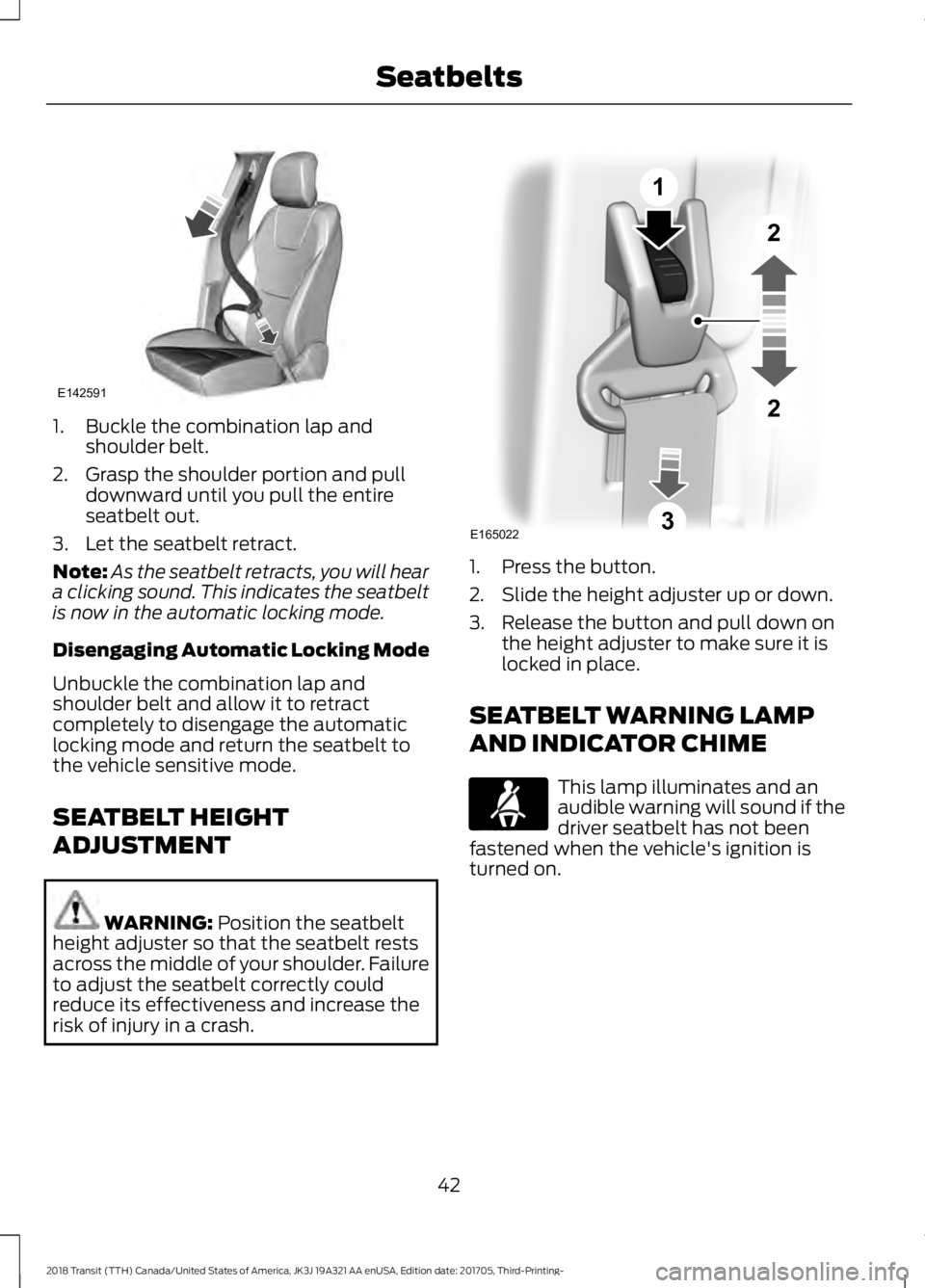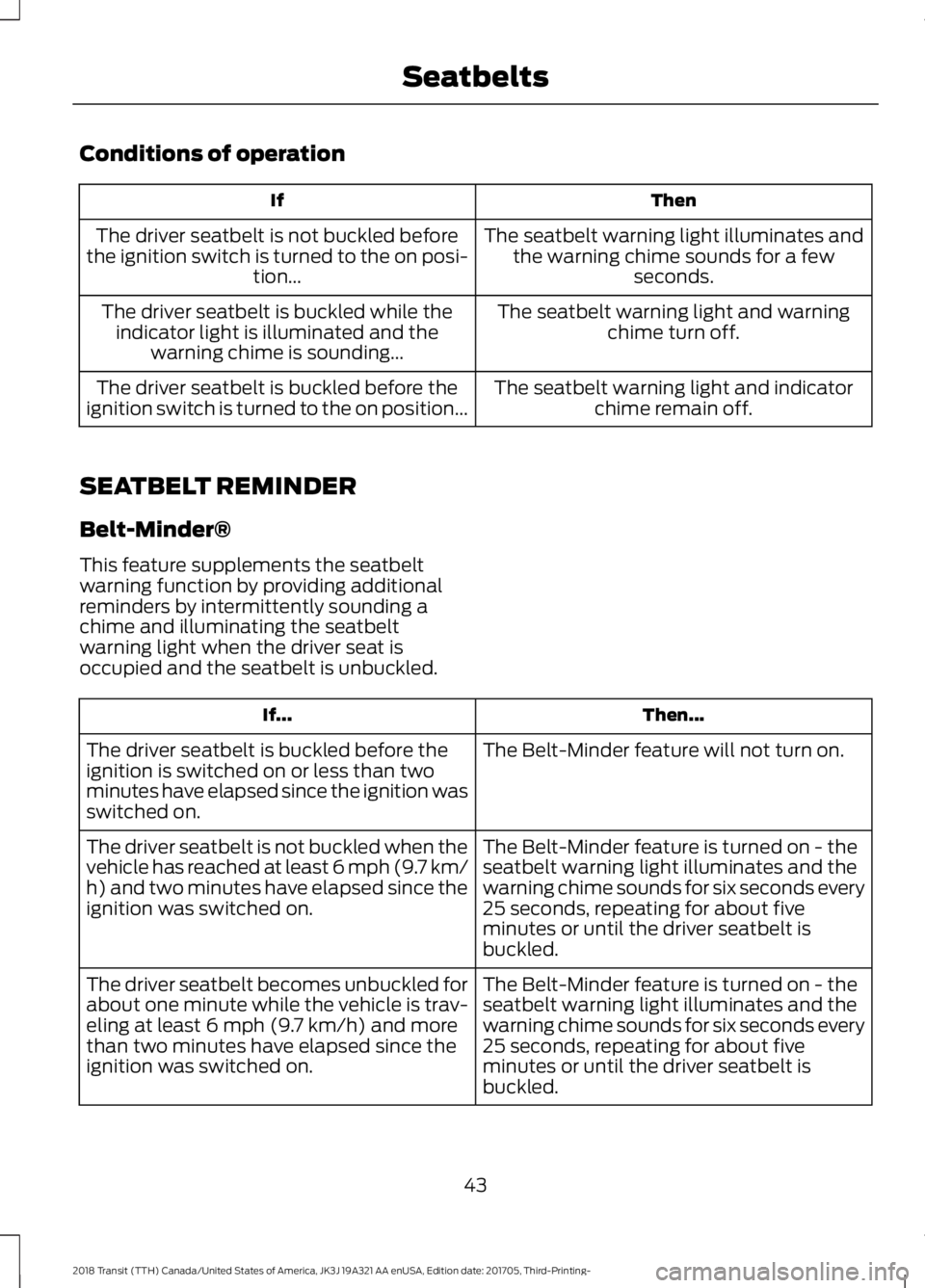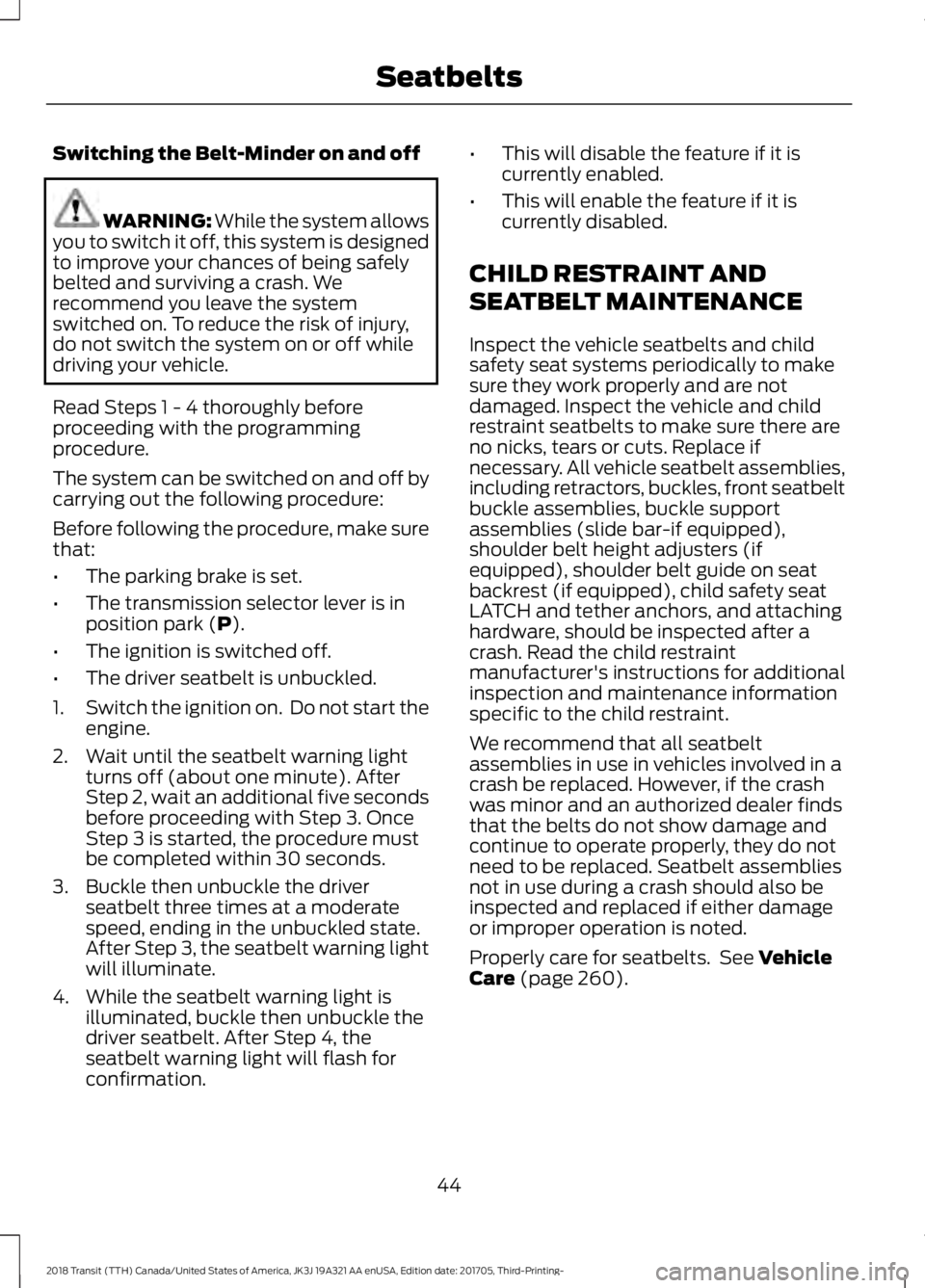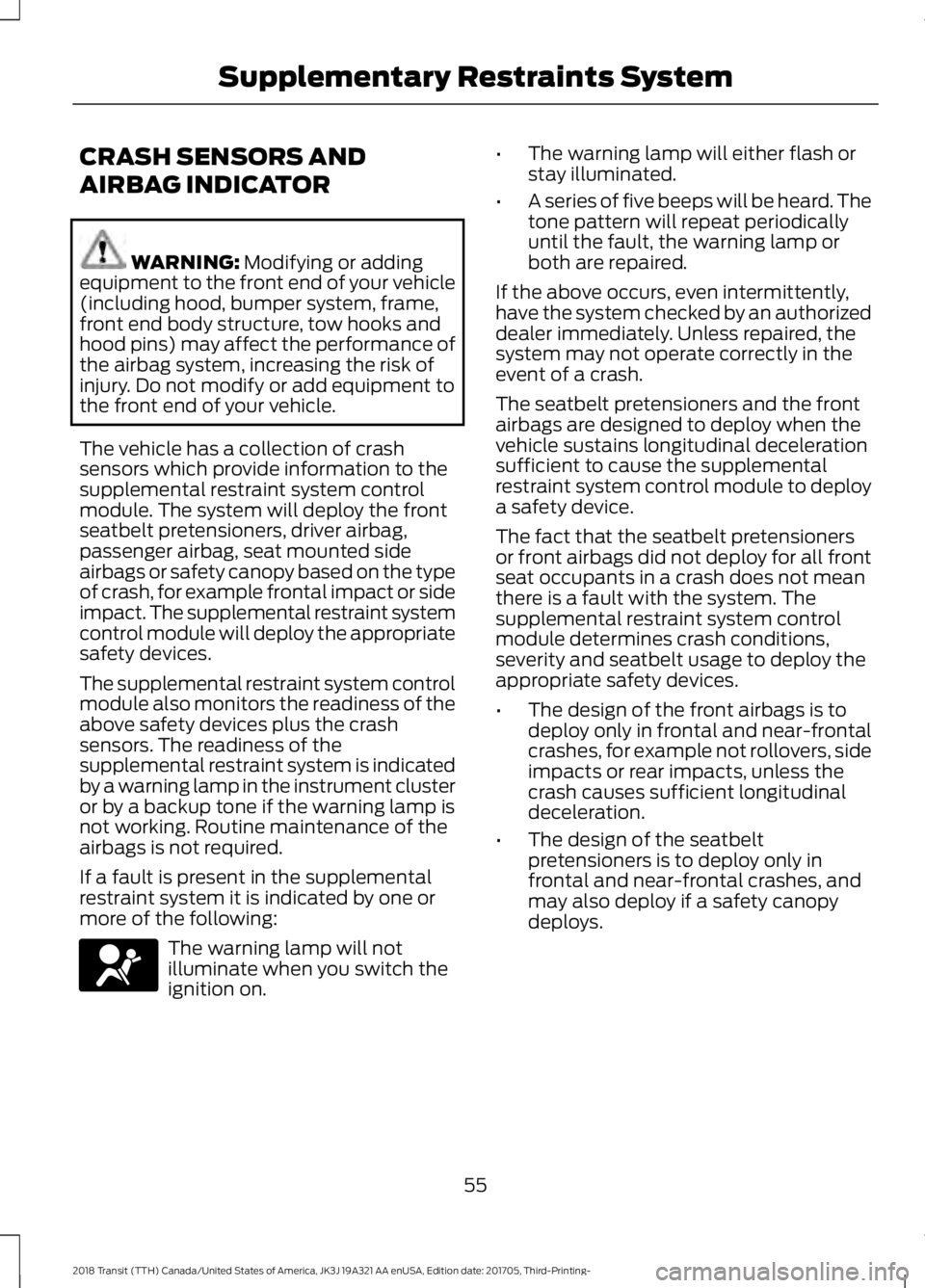2018 FORD TRANSIT ignition
[x] Cancel search: ignitionPage 5 of 521

Voice Control
...................................................81
Cruise Control ..................................................
81
Information Display Control ......................
82
Wipers and Washers
Windshield Wipers .......................................
83
Autowipers ......................................................
83
Windshield Washers ....................................
84
Lighting
General Information .....................................
85
Lighting Control .............................................
85
Autolamps .......................................................
86
Instrument Lighting Dimmer .....................
87
Daytime Running Lamps ............................
87
Direction Indicators .......................................
87
Interior Lamps ................................................
88
Cargo Lamps ..................................................
88
Windows and Mirrors
Power Windows ............................................
90
Exterior Mirrors ................................................
91
Interior Mirror ..................................................
92
Rear Quarter Windows ................................
92
Instrument Cluster
Gauges ..............................................................
93
Warning Lamps and Indicators ...............
95
Audible Warnings and Indicators ............
98
Information Displays
General Information ....................................
99
Trip Computer ...............................................
102
Personalized Settings ................................
102
Information Messages ...............................
103
Climate Control
Manual Climate Control ...........................
109Hints on Controlling the Interior Climate
........................................................................\
..
110
Rear Passenger Climate Controls ............
111
Heated Windows and Mirrors ...................
111
Remote Start ..................................................
112
Seats
Sitting in the Correct Position ..................
113
Head Restraints .............................................
113
Manual Seats .................................................
114
Power Seats ...................................................
116
Rear Seats .......................................................
118
Heated Seats ................................................
120
Auxiliary Power Points
Auxiliary Power Points ...............................
122
Cigar Lighter ...................................................
123
Storage Compartments
Cup Holders ...................................................
125
Overhead Console .......................................
125
Bottle Holder .................................................
125
Front Door Storage Compartment .......
125
Starting and Stopping the Engine
General Information ...................................
126
Ignition Switch ..............................................
126
Starting a Gasoline Engine .......................
127
Starting a Diesel Engine .............................
127
Switching Off the Engine ..........................
129
Engine Block Heater ...................................
129
Fuel and Refueling
Safety Precautions .......................................
131
Fuel Quality - Diesel ....................................
132
Fuel Quality - Gasoline ..............................
134
Fuel Quality - E85 ........................................
135
Fuel Filler Funnel Location .......................
136
Running Out of Fuel ...................................
136
2
2018 Transit (TTH) Canada/United States of America, JK3J 19A321 AA enUSA, Edition date: 201705, Third-Printing- Table of Contents
Page 45 of 521

1. Buckle the combination lap and
shoulder belt.
2. Grasp the shoulder portion and pull downward until you pull the entire
seatbelt out.
3. Let the seatbelt retract.
Note: As the seatbelt retracts, you will hear
a clicking sound. This indicates the seatbelt
is now in the automatic locking mode.
Disengaging Automatic Locking Mode
Unbuckle the combination lap and
shoulder belt and allow it to retract
completely to disengage the automatic
locking mode and return the seatbelt to
the vehicle sensitive mode.
SEATBELT HEIGHT
ADJUSTMENT WARNING: Position the seatbelt
height adjuster so that the seatbelt rests
across the middle of your shoulder. Failure
to adjust the seatbelt correctly could
reduce its effectiveness and increase the
risk of injury in a crash. 1. Press the button.
2. Slide the height adjuster up or down.
3. Release the button and pull down on
the height adjuster to make sure it is
locked in place.
SEATBELT WARNING LAMP
AND INDICATOR CHIME This lamp illuminates and an
audible warning will sound if the
driver seatbelt has not been
fastened when the vehicle's ignition is
turned on.
42
2018 Transit (TTH) Canada/United States of America, JK3J 19A321 AA enUSA, Edition date: 201705, Third-Printing- SeatbeltsE142591 E165022
1
2
2
3 E71880
Page 46 of 521

Conditions of operation
Then
If
The seatbelt warning light illuminates andthe warning chime sounds for a few seconds.
The driver seatbelt is not buckled before
the ignition switch is turned to the on posi- tion...
The seatbelt warning light and warningchime turn off.
The driver seatbelt is buckled while the
indicator light is illuminated and the warning chime is sounding...
The seatbelt warning light and indicatorchime remain off.
The driver seatbelt is buckled before the
ignition switch is turned to the on position...
SEATBELT REMINDER
Belt-Minder®
This feature supplements the seatbelt
warning function by providing additional
reminders by intermittently sounding a
chime and illuminating the seatbelt
warning light when the driver seat is
occupied and the seatbelt is unbuckled. Then...
If...
The Belt-Minder feature will not turn on.
The driver seatbelt is buckled before the
ignition is switched on or less than two
minutes have elapsed since the ignition was
switched on.
The Belt-Minder feature is turned on - the
seatbelt warning light illuminates and the
warning chime sounds for six seconds every
25 seconds, repeating for about five
minutes or until the driver seatbelt is
buckled.
The driver seatbelt is not buckled when the
vehicle has reached at least 6 mph (9.7 km/
h) and two minutes have elapsed since the
ignition was switched on.
The Belt-Minder feature is turned on - the
seatbelt warning light illuminates and the
warning chime sounds for six seconds every
25 seconds, repeating for about five
minutes or until the driver seatbelt is
buckled.
The driver seatbelt becomes unbuckled for
about one minute while the vehicle is trav-
eling at least 6 mph (9.7 km/h) and more
than two minutes have elapsed since the
ignition was switched on.
43
2018 Transit (TTH) Canada/United States of America, JK3J 19A321 AA enUSA, Edition date: 201705, Third-Printing- Seatbelts
Page 47 of 521

Switching the Belt-Minder on and off
WARNING: While the system allows
you to switch it off, this system is designed
to improve your chances of being safely
belted and surviving a crash. We
recommend you leave the system
switched on. To reduce the risk of injury,
do not switch the system on or off while
driving your vehicle.
Read Steps 1 - 4 thoroughly before
proceeding with the programming
procedure.
The system can be switched on and off by
carrying out the following procedure:
Before following the procedure, make sure
that:
• The parking brake is set.
• The transmission selector lever is in
position park (
P).
• The ignition is switched off.
• The driver seatbelt is unbuckled.
1. Switch the ignition on. Do not start the
engine.
2. Wait until the seatbelt warning light turns off (about one minute). After
Step 2, wait an additional five seconds
before proceeding with Step 3. Once
Step 3 is started, the procedure must
be completed within 30 seconds.
3. Buckle then unbuckle the driver seatbelt three times at a moderate
speed, ending in the unbuckled state.
After Step 3, the seatbelt warning light
will illuminate.
4. While the seatbelt warning light is illuminated, buckle then unbuckle the
driver seatbelt. After Step 4, the
seatbelt warning light will flash for
confirmation. •
This will disable the feature if it is
currently enabled.
• This will enable the feature if it is
currently disabled.
CHILD RESTRAINT AND
SEATBELT MAINTENANCE
Inspect the vehicle seatbelts and child
safety seat systems periodically to make
sure they work properly and are not
damaged. Inspect the vehicle and child
restraint seatbelts to make sure there are
no nicks, tears or cuts. Replace if
necessary. All vehicle seatbelt assemblies,
including retractors, buckles, front seatbelt
buckle assemblies, buckle support
assemblies (slide bar-if equipped),
shoulder belt height adjusters (if
equipped), shoulder belt guide on seat
backrest (if equipped), child safety seat
LATCH and tether anchors, and attaching
hardware, should be inspected after a
crash. Read the child restraint
manufacturer's instructions for additional
inspection and maintenance information
specific to the child restraint.
We recommend that all seatbelt
assemblies in use in vehicles involved in a
crash be replaced. However, if the crash
was minor and an authorized dealer finds
that the belts do not show damage and
continue to operate properly, they do not
need to be replaced. Seatbelt assemblies
not in use during a crash should also be
inspected and replaced if either damage
or improper operation is noted.
Properly care for seatbelts. See
Vehicle
Care (page 260).
44
2018 Transit (TTH) Canada/United States of America, JK3J 19A321 AA enUSA, Edition date: 201705, Third-Printing- Seatbelts
Page 51 of 521

WARNING: An airbag ON and OFF
switch may be installed in this vehicle.
Before driving, always look at the face of
the switch to be sure the switch is in the
proper position in accordance with these
instructions and warnings. Failure to put
the switch in a proper position can increase
the risk of serious injury or death in a crash. The front passenger airbag on and off
switch has indicators that will illuminate,
indicating that the front passenger frontal
airbag is either on or off. The indicator lamp
is located on the instrument panel.
Note:
The passenger airbag status indicator
OFF and ON lamps illuminate for a short
period of time when you switch the ignition
on to confirm it is functional. Passenger airbag
Passenger airbag status
indicator
Switch position
Disabled
OFF: Lit
Off
ON: Unlit Enabled
OFF: Unlit
On
ON: Lit
Turning the Passenger Airbag Off WARNING:
If the light fails to
illuminate when the passenger airbag
switch is off and the ignition is on, have the
passenger airbag switch serviced at your
authorized dealer immediately. WARNING:
In order to avoid
inadvertent activation of the switch,
always remove the ignition key from the
passenger airbag on and off switch. WARNING: An infant in a rear-facing
seat faces a high risk of serious or fatal
injuries from a deploying passenger airbag.
Rear facing infant seats should never be
placed in the front seats, unless the
passenger airbag is turned off.
48
2018 Transit (TTH) Canada/United States of America, JK3J 19A321 AA enUSA, Edition date: 201705, Third-Printing- Supplementary Restraints SystemE170613
Page 52 of 521

1. Insert the ignition key, turn the switch
to OFF and hold in OFF while removing
the key. 2.
When the ignition is turned on, the pass
airbag off light illuminates briefly,
momentarily shuts off and then turns
back on. This indicates that the
passenger airbag is deactivated.
Turning the Passenger Airbag Back On WARNING: The seatbelts for the
driver and right front passenger seating
positions have been specifically designed
to function together with the airbags in
certain types of crashes. When you turn off
your airbag, you not only lose the
protection of the airbag, you also may
reduce the effectiveness of your seatbelt
system, which was designed to work with
the airbag. If you are not a passenger who
meets the requirements stated in the
National Highway Traffic Safety
Administration or Transport Canada
deactivation criteria turning off the airbag
can increase the risk of serious injury or
death in a crash. WARNING:
If your vehicle has rear
seats, always transport children who are
12 years and under in the rear seat. Always
use seatbelts and child restraints correctly.
Do not place a child in a rear facing infant
seat in the front seat unless your vehicle is
equipped with an airbag on and off switch
and the passenger airbag is turned off. This
is because the back of the infant seat is
too close to the inflating airbag and the
risk of a fatal injury to the infant when the
airbag inflates is substantial. WARNING:
If the pass airbag off
light is illuminated when the passenger
airbag switch is on and the ignition is on,
have the passenger airbag switch serviced
at your authorized dealer immediately.
The passenger airbag remains off until you
turn it back on.
49
2018 Transit (TTH) Canada/United States of America, JK3J 19A321 AA enUSA, Edition date: 201705, Third-Printing- Supplementary Restraints SystemE181523 E181522
Page 53 of 521

1. Insert the ignition key and turn the
switch to ON.
2. The pass airbag off light will briefly illuminate when the ignition is turned
to on. This indicates that the passenger
airbag is operational.
The passenger side airbag should always
be on (the pass airbag off light should not
be illuminated) unless the passenger
meets the requirements stated either in
Category 1, 2 or 3 of the National Highway
Traffic Safety Administration or Transport
Canada deactivation criteria which follows.
The vast majority of drivers and passengers
are much safer with an airbag than
without. To do their job and reduce the risk
of life threatening injuries, airbags must
open with great force, and this force can
pose a potentially deadly risk in some
situations, particularly when a front seat
passenger is not using the seatbelt
correctly. The most effective way to reduce
the risk of unnecessary airbag injuries
without reducing the overall safety of your
vehicle is to make sure all passengers are
correctly restrained in the vehicle,
especially in the front seat. This provides
the protection of seatbelts and permits the
airbags to provide the additional protection
they were designed to provide. If you choose to deactivate your airbag, you are
losing the very significant risk reducing
benefits of the airbag and you are also
reducing the effectiveness of the seatbelts,
because seatbelts in modern vehicles are
designed to work as a safety system with
the airbags.
National Highway Traffic Safety
Administration Deactivation Criteria
(Excluding Canada)
WARNING: This vehicle has special
energy management seatbelts for the
driver and right front passenger. These
particular belts are specifically designed
to work with airbags to help reduce the risk
of injury in a crash. The energy
management seatbelt is designed to give
or release additional belt webbing in some
accidents to reduce concentration of force
on an occupant's chest and reduce the risk
of certain bone fractures and injuries to
underlying organs. In a crash, if the airbag
is turned off, this energy management
seatbelt might permit the person wearing
the belt to move forward enough to incur
a serious or fatal injury. The more severe
the crash, and the heavier the occupant,
the greater the risk is. Be sure the airbag is
turned on for any person who does not
qualify under the National Highway Traffic
Safety Administration deactivation criteria.
1. Infant.
An infant (less than 1 year old)
must ride in the front seat because:
• The vehicle has no rear seat;
• The vehicle has a rear seat too small
to accommodate a rear-facing infant
seat; or
• The infant has a medical condition
which, according to the infant's
physician, makes it necessary for the
infant to ride in the front so that the
driver can constantly monitor the
child's condition.
50
2018 Transit (TTH) Canada/United States of America, JK3J 19A321 AA enUSA, Edition date: 201705, Third-Printing- Supplementary Restraints SystemE181521
Page 58 of 521

CRASH SENSORS AND
AIRBAG INDICATOR
WARNING: Modifying or adding
equipment to the front end of your vehicle
(including hood, bumper system, frame,
front end body structure, tow hooks and
hood pins) may affect the performance of
the airbag system, increasing the risk of
injury. Do not modify or add equipment to
the front end of your vehicle.
The vehicle has a collection of crash
sensors which provide information to the
supplemental restraint system control
module. The system will deploy the front
seatbelt pretensioners, driver airbag,
passenger airbag, seat mounted side
airbags or safety canopy based on the type
of crash, for example frontal impact or side
impact. The supplemental restraint system
control module will deploy the appropriate
safety devices.
The supplemental restraint system control
module also monitors the readiness of the
above safety devices plus the crash
sensors. The readiness of the
supplemental restraint system is indicated
by a warning lamp in the instrument cluster
or by a backup tone if the warning lamp is
not working. Routine maintenance of the
airbags is not required.
If a fault is present in the supplemental
restraint system it is indicated by one or
more of the following: The warning lamp will not
illuminate when you switch the
ignition on. •
The warning lamp will either flash or
stay illuminated.
• A series of five beeps will be heard. The
tone pattern will repeat periodically
until the fault, the warning lamp or
both are repaired.
If the above occurs, even intermittently,
have the system checked by an authorized
dealer immediately. Unless repaired, the
system may not operate correctly in the
event of a crash.
The seatbelt pretensioners and the front
airbags are designed to deploy when the
vehicle sustains longitudinal deceleration
sufficient to cause the supplemental
restraint system control module to deploy
a safety device.
The fact that the seatbelt pretensioners
or front airbags did not deploy for all front
seat occupants in a crash does not mean
there is a fault with the system. The
supplemental restraint system control
module determines crash conditions,
severity and seatbelt usage to deploy the
appropriate safety devices.
• The design of the front airbags is to
deploy only in frontal and near-frontal
crashes, for example not rollovers, side
impacts or rear impacts, unless the
crash causes sufficient longitudinal
deceleration.
• The design of the seatbelt
pretensioners is to deploy only in
frontal and near-frontal crashes, and
may also deploy if a safety canopy
deploys.
55
2018 Transit (TTH) Canada/United States of America, JK3J 19A321 AA enUSA, Edition date: 201705, Third-Printing- Supplementary Restraints SystemE67017